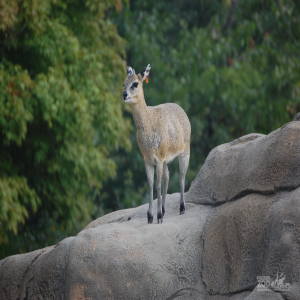Klipspringer
[Oreotragus oreotragus]

The Klipspringer has a head & body length of 30 to 45 inches. The tail length is 2 to 5 inches, with shoulder height of 18 to 24 inches and horns of 3 to 6 inches. Klipspringers weigh between 17.5 to 39.5 pounds. The coat has a yellowish olive gloss, speckled with yellow and brown or orange, shading to white below. The coat harmonizes with the background of rocks. The texture of the coat has been variously described as mosslike and grasslike. The thick, pithy hair lies like a mat on the body to cushion the animal against bumps and bruises in its rocky environment. Females have four mammae. Usually only males have horns.
Location: Animals Formerly at Zoo
Share:
Range
The range of the Klipspringer is Northern Nigeria, East Central African Republic, North East & South East Sudan, Ethiopia, Angola, and South` Africa.
Habitat
Klipspringers inhabit rocky hills & mountains.
Conservation Status
Least ConcernPrimary Threats
Gestation
Gestation lasts between 214 and 225 days.
Litter
1
Behavior
This little “cliff-springing” antelope might be likened to the chamois (Rupicapra rupicapra) or the mountain goat (Oreamnos americanus) in its mode of life among the rocks, where it makes rapid progress without apparent suitable footholds. A Klipspringer walks and stands on the tips of the relatively rounded hooves, and can jump onto a rocky projection the size of a silver dollar, landing on it with all four feet. It is crepuscular, being active mainly in the morning and late afternoon, sheltering at other times among rocks and under overhanging cliffs. Groups have exclusive home ranges, which are defended against conspecifics (individuals of the same species) and rarely left. Territories are larger in areas with low rainfall. Groups consist mainly of a mated, monogamous pair and their offspring of one or two years. The adult female initiates most group movements, but the male seems to be mainly responsible for defense. Generally, one member of the group stands at a point above the others and constantly watches for danger. When alarmed, it gives a loud, shrill whistle, and the animals ascend higher into the rocks. Both sexes scent mark the territory with secretions from the preorbital gland and by defecation.
Reproduction
Reproduction in Klipspringers is nonseasonal in south-central Africa, but in Ethiopia occurs in August and September. The weight of a newborn is about 2.2 lbs. The offspring remain hidden for 2 to 3 months, and weaning occurs at about 4 to 5 months. Young males separate from the group before they are one year old, but females remain longer, and may eventually mate with their father.
Wild Diet
Herbivorous, mainly grazers. Primary food is grass.
Zoo Diet
Fruit, yams, monkey chow, vitamin supplement
